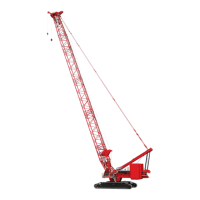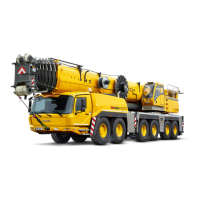Manitowoc Published 09-09-16, Control # 229-09 5-41
MLC650 SERVICE/MAINTENANCE MANUAL HOISTS
Drum 6 Hoisting Operation
See Figure 5-22 and Figure 5-24.
To enable the control system to drive the drum 6 pump and
motor, the switches listed below must be in the stated
positions:
• Seat safety switch closed
• Drum 6 park switch in the OFF position
NOTE: For the following operation, the drum 1 park switch
and/or left travel park switch are in the ON position.
When the drum 6 joystick is moved in the hoist up direction,
the CCM-10 control module energizes the drum 1 /drum 6
diverter solenoid valve, located in the accessory valve
manifold. When energized, the solenoid valve routes
hydraulic fluid to the pilot controls of the drum 1 / drum 6
diverter valve and the pump 1 charge pressure pilot valve.
The charge pressure and diverter pilot valves shift position,
allowing hydraulic fluid from pump 1 to flow to the drum 6
motor circuit.
The CCM-10 control module sends a signal to the IOLC32
control module via the controller area network bus (CAN
Bus) to ramp up the pulse-width modulation (PWM) duty
cycle to the A-side solenoid of pump 1 electronic
displacement control (EDC). The PWM signal is in proportion
to the speed commanded by the joystick. Increasing the
PWM duty cycle increases the pump swashplate angle,
which increases the hydraulic flow from the A-side of the
pump. From the pump, the flow is routed through the diverter
pilot valve and then into the A-side of the drum motor.
The CCM-10 control module sends a signal to the CCMC11
control module via the CAN Bus to ramp up the PWM duty
cycle to the drum 6 motor control solenoid. Increasing the
PWM duty cycle decreases the swashplate angle in the
motor, which increases the motor speed until the rotational
speed is maximized based on the pump flow.
The drum 6 motor speed sensor and pump 1 pressure
transducer (drum 1 psi) provide closed loop feedback. The
control algorithm uses this feedback to adjust the pump and
motor flows while ramping up to, and maintaining, the speed
commanded by the joystick.
Drum 6 Lowering Operation
See Figure 5-23 and Figure 5-24.
To enable the control system to drive the drum 6 pump and
motor, the switches listed below must be in the stated
positions:
• Seat safety switch closed
• Drum 6 park switch in the OFF position
NOTE: For the following operation, the drum 1 park switch
and/or left travel park switch are in the ON position.
When the drum 6 joystick is moved in the hoist down
direction, the CCM-10 control module energizes the drum 1 /
drum 6 diverter solenoid valve, located in the accessory
valve manifold. When energized, the solenoid valve routes
hydraulic fluid to the pilot controls of the drum 1 / drum 6
diverter valve and the pump 1 charge pressure pilot valve.
The charge pressure and diverter pilot valves shift position,
allowing hydraulic fluid from pump 1 to flow to the drum 6
motor circuit.
The CCM-10 control module sends a signal to the IOLC32
control module via the CAN Bus to ramp up the PWM duty
cycle to the B-side solenoid of pump 1 EDC. The PWM
signal is in proportion to the speed commanded by the
joystick. Increasing the PWM duty cycle increases the pump
swashplate angle, which increases the hydraulic flow from
the B-side of the pump. From the pump, the flow is routed
through the diverter pilot valve and then into the B-side of the
drum motor.
The CCM-10 control module sends a signal to the CCMC11
control module via the CAN Bus to ramp up the PWM duty
cycle to the drum 6 motor control solenoid. Increasing the
PWM duty cycle decreases the swashplate angle in the
motor, which increases the motor speed until the rotational
speed is maximized based on the pump flow.
The drum 6 motor speed sensor and pump 1 pressure
transducer (drum 1 psi) provide closed loop feedback. The
control algorithm uses this feedback to adjust the pump and
motor flows while ramping up to, and maintaining, the speed
commanded by the joystick.
